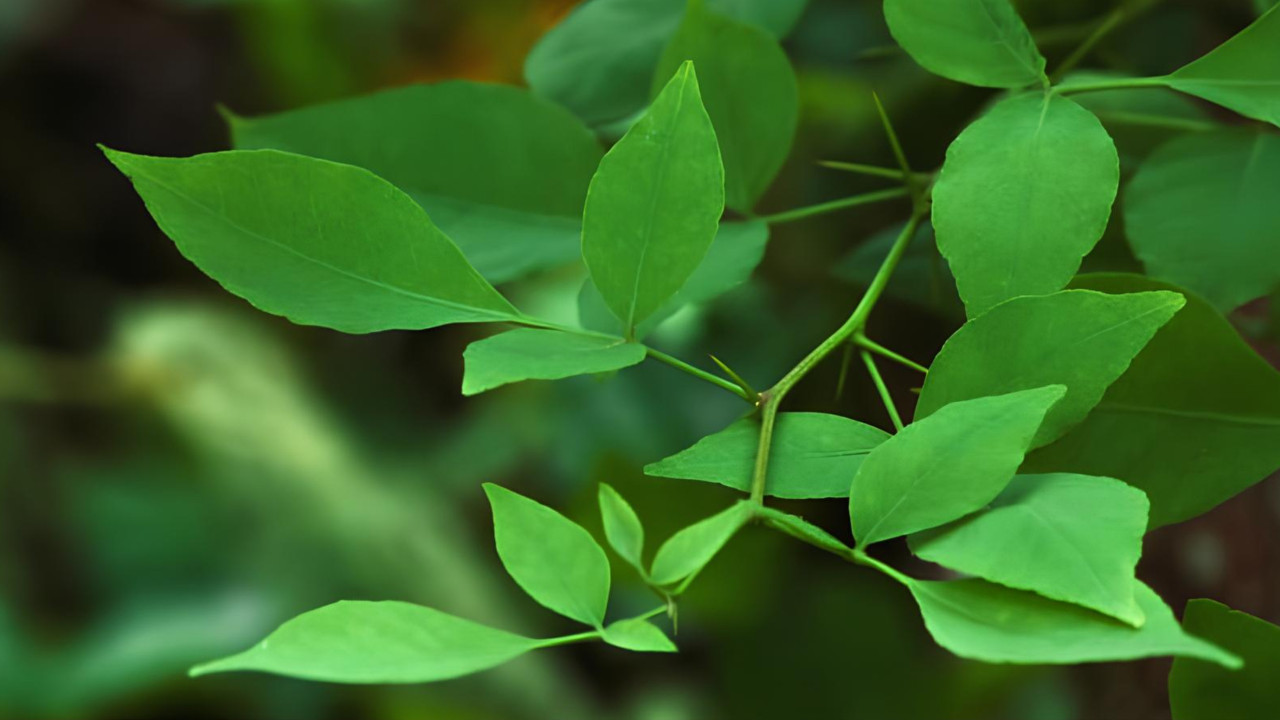Bilva (Aegle Marmelos): Health Benefits of Leaves, Fruits, and Roots
The Bael fruit (Aegle marmelos) is renowned in traditional Indian medicine, known as Ayurveda, for its extensive medicinal uses. The tree holds significant sacred value among Hindus due to its versatility. The leaves of the Bael tree are used not only for their medicinal properties but also as offerings to Lord Shiva and other deities. This “Bilva” tree is adaptable and grows throughout India, thriving in various soil types. It is characterized by its astringent, bitter, and dry qualities. The Bael tree is distinguished by its tall, robust stature, gnarled trunk, and sharp thorns.
This “Bilva” tree is adaptable and grows throughout India, thriving in various soil types. It is characterized by its astringent, bitter, and dry qualities. The Bael tree is distinguished by its tall, robust stature, gnarled trunk, and sharp thorns.
Its large, pale yellow fruits, known as ‘stone apples,’ resemble yellow suns when ripe. In Hindi, the fruit is called Bel or Bael Sripal, while in Sanskrit, it is referred to as Bilva, Pootivat, Sriphal, Lakshmiputra, Shaelpatra, and Shivesht. The botanical name of this tree is Marmelops Egle, and it belongs to the Rutaceae family.
Where Do Bael Trees Grow?
Bael trees, known for their medicinal and nutritional value, thrive in various climates across Asia and beyond. Here is an overview of their natural and cultivated range:
Native Regions
- Western Ghats of India: The Bael tree is originally native to this region, which includes parts of states like Maharashtra, Karnataka, Kerala, and Tamil Nadu.
Tropical and Subtropical Areas
- India: Widely cultivated across different parts of India, where the climate supports its growth.
- Nepal: Found in the subtropical and tropical regions.
Southeast Asia
- Bangladesh: Commonly grown and used in traditional medicine.
- Pakistan: Cultivated in various regions, particularly in the subtropical and tropical areas.
- Sri Lanka: Grown throughout the country.
- Cambodia: Found in the tropical climate.
- Vietnam: Cultivated in various parts of the country.
- Malaysia: Grown in tropical regions.
- Java (Indonesia): Part of the diverse flora in the region.
- Thailand: Found in tropical areas.
- Philippines: Cultivated in suitable climates.
Extended Regions
- Fiji: Introduced and cultivated in the tropical climate.
Other Names of Bael Tree Leaves
Bael tree is known by various names throughout India as well as in other countries, below are some of its popular names.
In India
- Sanskrit (Bilva, sriphal, shivadruma, Shivapala)
- Bengali (Bel)
- Hindi (Bel, bael, sripal)
- Gujrati (Bil)
- Telugu (Maredu)
- Tamil (Kuvalum)
- Kannada (Bilpatra, kumbala, malura)
Around the world
- Cambodia (Phneou or pnoi)
- Java (Modjo)
- Thai (Matum and mapin)
- Malayan (Maja pahit)
- Vietnamese (Bau nau)
- Portuguese (Marmelos)
- French (Oranger du Malabar)
Medicinal Properties of Bilva Trees
Among the many Ayurvedic herbs, herbs Bilva is also very important. In Ayurveda, every part of the Bilva tree is used for medicinal purposes in Ayurvedic medicine.
The unripe Bilva fruit roasted under mud, pureed, and mixed with honey and water or buttermilk can be the best medicine as an antimicrobial and anti-inflammatory.
It can be used for the treatment of diabetes, digestive issues. Besides this, the fruit is also can be used for heart-related problems, the brain, and for fertility.
Nutritional Value of Bael Fruit (Per 100 g Pulp)
The Bael fruit (Aegle marmelos) is known for its rich nutritional profile. Here is the breakdown of its key nutrients:
1. Vitamin C: 8 mg
- Essential for immune function, collagen synthesis, and antioxidant protection.
2. Riboflavin (Vitamin B2): 1.19 mg
- Important for energy production, skin health, and cellular function. Bael fruit has a notably high riboflavin content compared to other fruits.
3. Water: 61.5 g
- Contributes to hydration and supports various physiological processes.
4. Thiamine (Vitamin B1): 0.13 mg
- Helps in carbohydrate metabolism and nerve function.
5. Protein: 1.8 g
- Supports tissue repair, immune function, and overall growth.
6. Carotene: 55 mg
- A precursor to Vitamin A, important for vision, immune health, and skin integrity.
7. Fat: 0.39 g
- Minimal fat content, contributing to a low-calorie profile.
8. Carbohydrates: 31.8 g
- Provides a source of energy through sugars and starches.
9. Minerals: 1.7 g
- Includes essential minerals like calcium, potassium, and magnesium that support various bodily functions.
10. Niacin (Vitamin B3): 1.1 mg
- Aids in digestion, energy production, and maintaining healthy skin.
Notable Points
- High Riboflavin Content: As noted by Gopalan et al. (1971), Bael fruit is exceptionally high in riboflavin compared to other fruits, making it a valuable source of this essential vitamin.
- Low Fat and Rich in Carbohydrates: The fruit is low in fat and provides a substantial amount of carbohydrates, making it a good source of energy.
- Hydration and Nutritional Support: The high water content supports hydration, while vitamins and minerals contribute to overall health and well-being.
Bael fruit’s nutritional value underscores its role as a healthful addition to the diet, providing essential vitamins, minerals, and energy in a low-fat, hydrating form.
1. Bael leaves medicinal uses
In Ayurveda, Bilva leaves (Aegle marmelos) are highly revered for their therapeutic properties, with a long history of use for balancing the body’s doshas (Vata, Pitta, and Kapha). Here are some Ayurvedic benefits of Bael (Bilva) leaves:
1. Balancing Doshas: Bilva leaves are traditionally used in Ayurvedic medicine to balance excess Vata (air) and Kapha (phlegm) doshas. They help alleviate conditions associated with these doshas, such as joint pain, respiratory issues, and digestive disturbances.
2. Diabetes Management: Regular consumption of Bilva leaves can be beneficial for managing diabetes mellitus. Chewing a few leaves daily and drinking fresh juice extracted from the leaves can help regulate blood sugar levels and improve overall insulin sensitivity.
3. Diaphoretic Effects: The leaves have diaphoretic properties, meaning they promote sweating. This helps in reducing body temperature and alleviating fevers, making them useful during illnesses that cause elevated body temperatures.
4. Aphrodisiac Properties: Bilva leaves are considered to have aphrodisiac properties, potentially improving sexual health and vitality.
5. Seasonal Health Remedies: A decoction made from Bilva leaves is a favored remedy for seasonal ailments. It is commonly used to treat fever, flu, and fatigue that often occur during changes in seasons.
6. Additional Benefits: The leaves support overall health by aiding digestion, improving respiratory function, and boosting the immune system.
Bilva leaves offer a range of benefits from balancing doshas and managing diabetes to alleviating seasonal ailments and enhancing general well-being.
Their diverse uses in traditional medicine underscore their significance in maintaining health and treating various conditions.
2. Bilva Fruit’s medicinal uses
In Ayurveda, Bilva fruits (Aegle marmelos) are highly valued for their therapeutic properties, with a long history of use to balance the body’s doshas (Vata, Pitta, and Kapha). Here are some Ayurvedic benefits of Bael (Bilva) fruits:
1. Digestive Health: The pale fawn flesh of Bilva fruit is sweet and astringent, thanks to its tannin content. This makes it effective in tightening and toning the tissues of the bowels, helping to manage conditions such as diarrhea and dysentery.
2. Flavor and Aroma: Bilva fruit is noted for its sweet, pleasant taste and aromatic qualities. This makes it not only enjoyable to eat but also a flavorful addition to various culinary dishes.
3. Nutritional Supplement: The fruit provides an excellent dietary supplement due to its nutritional profile, offering essential vitamins and minerals that support overall health.
4. Medicinal Preparation
- Dietary Bel: When the dried pulp of Bilva fruit is powdered and mixed with arrowroot, it is known as “dietary Bel.” This preparation serves a dual purpose:
- Food: It acts as a nutritious food ingredient.
- Healing Medicine: It combines the health benefits of Bilva fruit and arrowroot, making it a valuable remedy for digestive issues and general health maintenance.
3. Bilva Root medicinal uses
In Ayurveda, Bilva roots (Aegle marmelos) are highly esteemed for their therapeutic properties, with a long tradition of use in balancing the body’s doshas (Vata, Pitta, and Kapha). Here are some Ayurvedic benefits of Bael (Bilva) roots:
1. Treatment for Vomiting: A traditional remedy involves preparing a mixture of ginger root and toasted rice. This preparation is used to alleviate vomiting and settle the stomach.
2. Relief for Hemorrhoids and Digestive Disorders: Bilva root, when mixed with a tuberous root, is used to treat hemorrhoids (piles), dysentery, and diarrhea. This combination helps soothe and heal the digestive tract, addressing these conditions effectively.
3. Nasal and Ear Health: Oil extracted from Bilva root, when boiled with Bilva leaf juice and applied to the head, is beneficial for treating nasal catarrh (excessive mucus production) and ear diseases. This application provides relief from symptoms and promotes healing.
4. Antibacterial Properties: Research has demonstrated that extracts of Bilva fruits, roots, and leaves exhibit activity against various bacterial strains. This highlights the antimicrobial potential of Bilva in combating infections.
5. Additional Benefits: The root’s medicinal properties make it a valuable component in traditional medicine for treating a range of conditions, from digestive issues to respiratory ailments.
Bilva root is an important part of Ayurvedic medicine, offering diverse therapeutic benefits. Its applications extend from digestive health to respiratory relief and antibacterial action, underscoring its versatility and effectiveness in traditional remedies.
Top 10 Medicinal Uses of Bel Patra
Aegle marmelos, commonly known as Bael or Bael fruit, is a tree native to India and has been used for centuries in traditional medicine systems like Ayurveda.
The various parts of the Aegle marmelos tree, including its leaves, fruit, bark, and roots, are known to possess medicinal properties. Here are some of the medicinal uses of Aegle marmelos:
1. Promotes Digestive Health
Bel Patra has carminative, digestive, and laxative properties that aid in the smooth functioning of the digestive system. It also helps in reducing bloating and gas formation by promoting the proper breakdown of food.
How to Use:
- You can chew fresh Bel Patra leaves or make a powder from dried leaves and take it with honey for treating indigestion, constipation, or bloating.
- Alternatively, drink Bel Patra tea by boiling the leaves in water for a soothing effect on digestion.
2. Regulates Blood Sugar Levels
The leaves possess hypoglycemic properties that help regulate blood sugar levels in diabetic patients. It also supports insulin secretion and glucose absorption, making it beneficial for overall metabolic function.
How to Use:
- Consume Bel Patra juice (freshly squeezed) on an empty stomach every morning to help regulate blood sugar levels.
- Alternatively, mix Bel Patra powder with water or honey and consume it regularly for better glucose control.
3. Supports Liver Health
Bel Patra has hepatoprotective and detoxifying properties, which protect the liver from toxins and help it function optimally. It also enhances the liver’s ability to regenerate and remove harmful substances from the body.
How to Use:
- Drink Bel Patra juice regularly to detoxify the liver and promote its health.
- Bel Patra leaves can also be boiled in water to prepare a medicinal decoction, which can be consumed daily to support liver function.
4. Anti-inflammatory Benefits
The leaves have anti-inflammatory and analgesic properties that help in reducing inflammation and pain. They can reduce swelling and calm irritated tissues, making them ideal for treating arthritis and muscular pain.
How to Use:
- Apply a paste of crushed Bel Patra leaves topically to inflamed joints or muscles to reduce swelling and pain.
- Consuming Bel Patra powder mixed with warm water can also help alleviate internal inflammation.
5. Boosts Immunity
Rich in antioxidants, vitamins, and alkaloids, Bel Patra helps to strengthen the immune system. It aids in neutralizing free radicals, preventing oxidative damage, and supporting the body’s natural defense mechanisms.
How to Use:
- Regular consumption of Bel Patra juice or Bel Patra powder (mixed with honey or warm water) can help boost immunity and prevent infections.
- You can also make a herbal infusion by steeping Bel Patra leaves in hot water for a healthy immune boost.
6. Improves Respiratory Health
Bel Patra has expectorant, antibacterial, and anti-inflammatory properties that help treat respiratory issues. It can clear mucus from the airways and ease breathing in conditions like asthma and bronchitis.
How to Use:
- Boil Bel Patra leaves in water and inhale the steam to clear the respiratory passage.
- Drink a tea made from Bel Patra leaves to soothe a cough, bronchitis, or asthma symptoms.
7. Reduces Fever
With its antipyretic (fever-reducing) properties, Bel Patra helps in lowering body temperature during a fever. It also has a cooling effect, which helps the body in fighting fever more efficiently.
How to Use:
- Drink Bel Patra juice or decoction made from the leaves to help bring down fever.
- Bel Patra leaves can also be boiled and consumed to treat fevers associated with infections or viral illnesses.
8. Promotes Skin Health
The antimicrobial, anti-inflammatory, and antioxidant properties of Bel Patra help treat skin conditions like acne, eczema, and infections. It also promotes faster wound healing and reduces scars or blemishes.
How to Use:
- Apply a paste of crushed Bel Patra leaves directly to the skin to treat acne, wounds, or rashes.
- Drink Bel Patra juice or use it as a face wash to cleanse and rejuvenate the skin.
9. Supports Heart Health
Bel Patra has cardioprotective properties that help regulate cholesterol levels, improve circulation, and support overall heart function. It also helps in reducing blood pressure, promoting a healthy heart.
How to Use:
- Drink Bel Patra juice or take Bel Patra powder mixed with warm water regularly to support heart health and manage blood pressure.
10. Enhances Mental Clarity and Reduces Stress
Bel Patra has calming and nerve-soothing properties that help reduce stress and enhance mental clarity. It also improves focus and cognitive function by promoting better blood flow to the brain.
How to Use:
- Drinking a warm Bel Patra infusion before bedtime can help calm the nervous system and promote better sleep.
- Regular consumption of Bel Patra juice or powder can reduce anxiety and improve focus and mental clarity.
FAQ’s
1. What is Bilva Patra used for?
Bilva Patra (Bael leaves) are widely used in Ayurveda for their medicinal properties. They are known to improve digestion, regulate blood sugar levels, support liver health, and boost immunity. The leaves are also used in traditional rituals, especially in the worship of Lord Shiva.
2. Can we eat Bel Patra daily?
Yes, Bel Patra can be eaten daily, but it is advisable to consume it in moderation. Daily consumption of Bel Patra helps in improving digestion, boosting immunity, and maintaining overall health. It is recommended to consult a healthcare professional for the appropriate dosage.
3. How to identify Bilva leaf?
Bilva leaves (Bael leaves) are trifoliate, meaning they consist of three leaflets arranged in a cluster. The leaflets are rough and leathery with a distinctive shape — broad and oval with pointed tips. The leaves are green in color and have a strong, aromatic smell.
4. Why does Lord Shiva like Bilva Patra?
Lord Shiva is believed to favor Bilva Patra because it is considered a symbol of purity and is said to have the ability to cleanse one’s soul. Offering Bilva leaves to Lord Shiva is believed to purify the mind and body and earn divine blessings.
5. Can we keep Bilva leaves at home?
Yes, you can keep Bilva leaves at home. They are considered auspicious and are often used in religious rituals. In Ayurveda, they are also used for their healing properties. Keeping Bilva leaves at home is believed to bring positive energy and good health.
6. Is wood apple good for kidney patients?
Wood apple (Bael fruit) can be beneficial for kidney patients in moderation. It helps in detoxification and supports kidney function. However, it’s important for kidney patients to consult their doctor before consuming it, as individual health conditions vary.
7. Can we grow Bilva Patra at home?
Yes, Bilva Patra (Bael tree) can be grown at home. It prefers a warm climate and well-drained soil. You can grow it in a garden or in a large pot with proper care. It requires ample sunlight and regular watering to thrive.
8. How to eat Bael Patra?
Bael Patra (Bilva leaves) can be consumed in various forms:
- Fresh leaves can be chewed directly or used to prepare herbal teas.
- Dried leaves can be powdered and mixed with water, honey, or ghee for digestive health and detoxification.
9. How to offer Bilva Patra to Shiva?
To offer Bilva Patra to Lord Shiva:
- Clean the leaves thoroughly.
- Offer a set of three leaves (symbolizing the trinity of Lord Shiva) to the Shiva Lingam during prayers.
- It’s often accompanied by chanting mantras like “Om Namah Shivaya” for blessings and purification.
10. Is bael good for the liver?
Yes, Bael fruit (wood apple) and its parts, including the leaves, are known to support liver health. They have detoxifying and hepatoprotective properties that help in cleansing the liver and enhancing its function.
11. What are the benefits of eating Bilva leaves?
Eating Bilva leaves offers several health benefits, including improved digestion, reduced inflammation, blood sugar regulation, liver detoxification, and enhanced immunity. They also have antibacterial and antifungal properties.
12. On which day we should not pluck Bel Patra?
In Hindu traditions, it is believed that Bel Patra should not be plucked on Tuesdays and Saturdays as these days are considered inauspicious for harvesting the leaves. However, they are commonly offered to Lord Shiva on Mondays and during the auspicious period of Shravan (the fifth month of the Hindu calendar).
Bilva (Aegle marmelos) is not only a sacred plant but also a powerful medicinal herb with diverse applications in health and wellness. Its traditional uses, backed by modern research, affirm its role as a cornerstone in holistic healing practices.


























